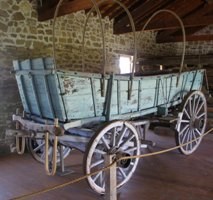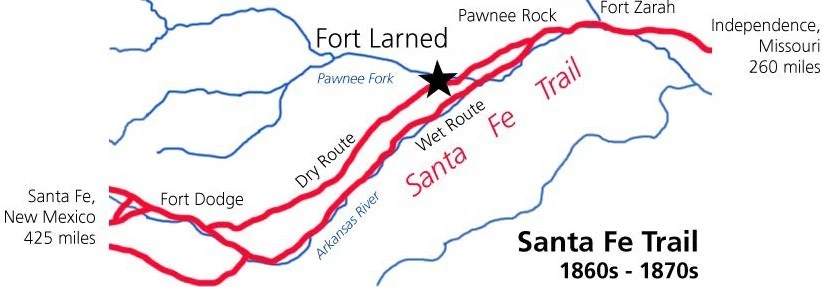
NPS Photo
|
|
When William Becknell’s pack train first traced through prairies of the Southern Plains in 1821, its passage through these vast, wild lands marked the beginning of decades of rapid political, social, and ecological change. Through its primary use as a trade route, the Santa Fe Trail contributed to a vibrant cultural exchange and, over time, a lasting cultural shift as American society spread across the Great Plains. Trade on the Santa Fe Trail brought some cultures together as much as it tore others apart. |
The Opportunity
NPS From the 1820s to the 1870s, the Santa Fe Trail was a vital commercial route. Although the trail was also used by some settlers and travelers continuing west to places like California, most Santa Fe Trail users were motivated by the promise of profit. Intrepid traders loaded their wagons with goods such as textiles and manufactured goods produced in the United States and hauled them overland to Santa Fe for sale. The nearly 800 mile journey took an average of two months to complete one way. After selling their goods in Santa Fe, the traders returned east with gold, silver, mules, and other goods acquired in Santa Fe. Mexican traders made the same journey on the Santa Fe Trail in the opposite order. |
The RisksThose who undertook the journey from Independence, Missouri to Santa Fe and back had much to gain and everything to lose. While some travelers made the trip without incident, the unforgiving climate, illness, mechanical failures, starvation, dehydration, and the potential for violent encounters created an array of challenges to prepare for and overcome. While some struck it rich, others lost their fortunes, their health, or their lives. “I wondered, too, if the breezes that swept this high table-land could speak, what tales of snowstorms, of sand storms, of freezing and starving cattle, or perishing men, it would whisper in our ears,” wrote Santa Fe Trail traveler Hezekiah Brake in 1858. |
US Army Protection
NPS Fort Larned was established in response to hostilities along the Santa Fe Trail. “It is a proper place for a military post, and should be the depot of supplies for any troops acting against Indians on that line,” reported Maj. John C. McFerran in 1865, as construction was beginning on the sandstone buildings of the fort. Fort Larned is situated directly on the Dry Route of the Santa Fe Trail, which follows the Pawnee Fork of the Arkansas River. Fort Larned is just a few miles north of the Wet Route, which more closely follows the Arkansas River. |

NPS |
|
Fort Larned was one of a series of forts along the Santa Fe Trail spaced to provide adequate protection along the entire trail. Fort Zarah to the northeast and Fort Dodge to the southwest were Fort Larned’s nearest neighbors along the Santa Fe Trail. Fort Hays, located nearer the railroad route that eventually eclipsed the Santa Fe Trail, was about 60 miles to the north. Fort Larned’s troops patrolled the Santa Fe Trail 70 miles in either direction from the fort, and at some times, escorted wagon trains down the trail to deter attacks. In time, Fort Larned and other forts along the Santa Fe Trail played their part in establishing lasting U.S. control over the Great Plains. |
Legacy PreservedAlthough the last wagon train passed by well over 100 years ago, and most of the trail has been erased by newer roads, cities, and agricultural fields, there are still places where visitors can see the original trail ruts carved by thousands of passing wagons so long ago. Visitors to Fort Larned National Historic Site can view historic Santa Fe Trail ruts at a detached park site five miles from the fort via gravel roads.
Travelers interested in exploring other sites along the Santa Fe Trail can find more information on the Santa Fe National Historic Trail website. |
Last updated: February 2, 2024
